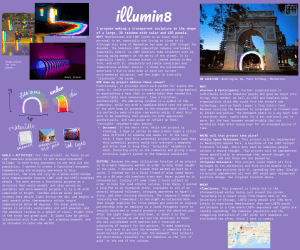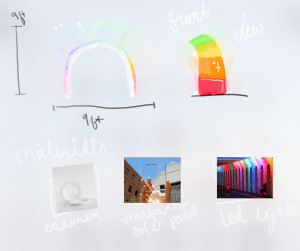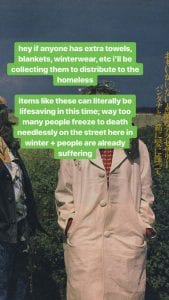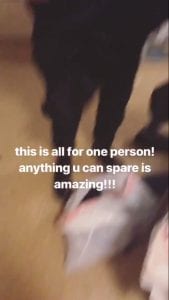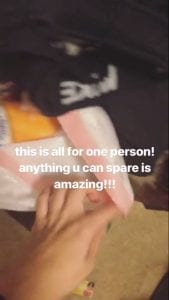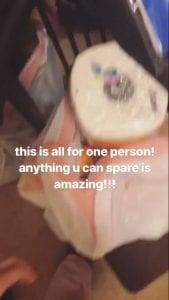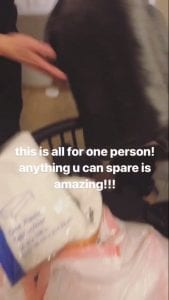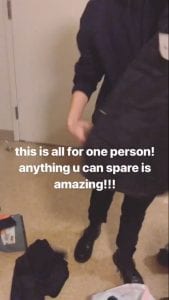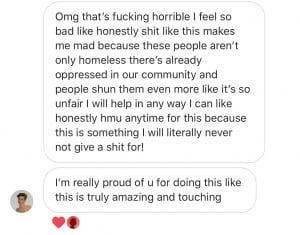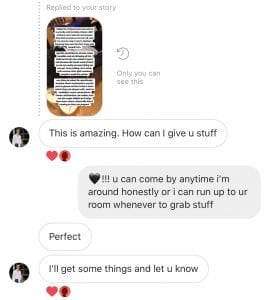Final Proposal Board
PURPOSE
Homelessness and LGBT youth is an issue that is personal to me, especially now living so close to it. Although this area of Manhattan has been an LGBT hotspot for decades, the homeless LGBT population remains overlooked, especially elders– no LGBT shelters take residents over 241, leaving aging members at the mercy of the street. It is especially timely, because winter is indeed coming to New York, and with it, absolutely unlivable conditions and temperatures without shelter. I chose the sustainable materials I did to also keep in mind our current environmental situation, and the light to literally “illuminate” the issue.
DESCRIPTION
For this project, my focus is on LGBT Homeless population in and around Greenwich Village. To both bring awareness to and help out the population, I wanted to create a functional monument. Commemorating and bringing awareness to this population, the area and city as a whole would become more compassionate towards LGBT (and non-LGBT) homeless people. The work serves a functional purpose as a structure that emits warmth, but also serves an aesthetic and environmental purpose.
It is a 3D arch comprised of bright, rainbow colored LEDs under transparent solar panels (held together by white enamel) that absorb light during the day, and begins to emit warmth after thermometers within record temperatures below 50 degrees.2 The solar paneling leaves it entirely sustainable and self-powered3, and the seamless rainbow is a splash of clean, bright color in the brown and green park. It looks like an gently illuminated arch from afar, but standing beneath, one is shrouded in color and warmth.
To make something more long term to go with the monument, a community drive could be held periodically near the monument that collects and distributes resources for the homeless as the “pot of gold” at the end of the rainbow.
LOCATION
This project will be implemented in Washington Square Park, a keystone of the LGBT hotspot
Greenwich Village– “Both the third-ever Pride Parade in 1973 and the first-ever Dyke March in 1993 ended in Washington Square Park.”4 It is also a place where many pass by homeless people without a second thought. This project will be implemented there specifically to encourage that second thought in passersby, and aid those who are passed by.
IMPACT
Functionally, it provides short-term warmth for anyone who needs it, while preventing overuse and unwanted congregation by maintaining a heat that is comfortable when needed but uncomfortable once unnecessary, like a hairdryer. This is a way to help out homeless people and offer them a semblance of shelter without violating strictures that prohibit encouraging the homeless to congregate, and a contradiction to the recent widespread appearance of anti-homeless architecture.5 Aesthetically, the embracing rainbow is a symbol of the community, while the arch’s seamless blend into the ground of the park keep it grounded to the neighborhood itself, and its perfectly semi-circular shape that naturally flows into the ground like a root represents unity. I want this work to be something that people can both appreciate aesthetically, and take pause to reflect on their “invisible” neighbors upon seeing. In the short term, while the project is standing, I hope it serves to make a hard night a little less difficult to someone who needs it. In the long term, I hope that this potential project would hope that this potential project would would stir everyone’s sympathy and drive them to keep their “invisible” neighbors in mind, fostering unity in the community and giving a more extensive support system to the homeless population.
WHY NOW?
“LGBTQ youth had over twice the rate of early death among youth experiencing homelessness. LGBTQ youth are at more than double the risk of homelessness compared to non-LGBTQ peers. Among youth experiencing homelessness, LGBTQ young people reported higher rates of trauma and adversity.” In a time where LGBT+ awareness and rights are rapidly expanding, the homeless population and the staggering statistics of LGBT youth left homeless are overlooked too often, which I want to combat.
MATERIALS
Rainbow LEDs, Transparent Glass Solar Panels, White Enamel
IMAGES
Gesture images below.
BRAINSTORMING
Why do you believe this subject matter is deserving of commemoration?
For my Bridge 4 project, I decided to focus on LGBT Homeless population in and around the Greenwich Village neighborhood. Although this area of Manhattan has been an LGBT hotspot for decades, the homeless LGBT population remains overlooked, especially elders– no LGBT shelters take residents over 24, leaving aging members at the mercy of the street. In order to both bring awareness to and help out the population, I wanted to create a functional monument.
How do you think commemorating this particular subject matter would alter the neighborhood and the city?
I think by drawing commemorating and drawing awareness to this population, the area and city as a whole would become more compassionate towards LGBT (and non-LGBT) homeless people. In conversation with a homeless trans man with whom I collaborated with to inspire this project, he told me that the people that most look down on him are white gay males. I hope that this potential project would stir everyone’s sympathy and drive them to help.
Relationship of the work to the site and the host community, especially how it serves to activate or enhance public space;
The work serves a functional purpose as a structure that emits warmth, but also serves an aesthetic and environmental purpose. It is a 3D arch comprised of bright, rainbow colored solar panel screens that absorb light during the day, and begins to emit warmth after thermometers within record temperatures below 40 degrees. The solar paneling leaves it entirely sustainable and self-powered, and the seamless rainbow is a splash of clean, bright color in the brown and green park.
What message do you aim for this work to convey?
The rainbow is a symbol of the community, while the arch’s seamless blend into the ground of the park keep it grounded to the neighborhood itself, and its perfectly semi-circular represents unity. I want this work to be something that people can both appreciate aesthetically, and take pause to reflect on their “invisible” neighbors upon seeing.
ON-SIGHT RESEARCH – GESTURE
Choose a solution to develop and actualize it via onsite action research
For my gesture, I decided to reach out directly to my local LGBT homeless population through a connection I had made previously. Because the main utilitarian function of my project is to create temporary warmth in order to help those caught in the cold, I decided to create that warmth as best as I could.
I reached out to a local friend of mine named Razer, who is a 50 year old homeless trans man. He has no record, but can not stay in LGBT shelters due to his age, and is assaulted in mens shelters. Therefore, he and many like him are stuck on the streets in winter, where temperatures can often dip below zero at night. It is in this time that many homeless people freeze to death on the street.
Razer’s contact information and short list.
Razer guided me in conversation, listing off some items I could collect in order to help combat this fate that many would be subjected to. From there, I posted a long PSA on my instagram story, available to all of my several thousand followers, bringing awareness to Razer’s story, and then inviting donations. While I waited for the responses to (hopefully) pour in, my roommates and I who are all LGBT+ collected items of our own to add to the donation pool.
Above are some screenshots from the series posted. The response I ended up receiving was tremendous; in one night we collected more than enough supplies for three people and secured an ongoing partnership with an employee at a local Patagonia store to recycle discarded or unsold products into the donation pool. After the night began to wind down, at about 3 in the morning, we suited up and carried the donations to Razer, who was overwhelmed with emotion. We talked with him for over half an hour about what these donations would do, life on the street, and just normal pleasant and unpleasant things that homeless people often lose the luxury of talking about with others.
3 of many messages.
In addition to people wanting to help, I also received a number of messages thanking me for bringing awareness to the issue, even from “white gay males” that Razer told me look down on him most in the street, and some friends I personally thought were a bit mean and cold. This changed my perception of my friends for the better, and helped several people keep warm and safe, all in one night.
REFLECTION ON YOUR PROJECT
IMAGINING THE NEIGHBORHOOD REACTION IF THIS WAS PIECE WAS BUILT.
I imagine there would be some local backlash due to its possible ability to draw homeless to congregate or loiter in Washington Square Park, however, due to the precautions taken to prevent this as well as general accessibility for all people, I would hope that this would not be too significant of an issue and that the monument can be enjoyed by locals and visitors alike.
WHAT WERE YOUR BIGGEST DISCOVERIES THROUGH THIS PROJECT AND THIS SEMESTER?
Over the course of the semester, the thing I was more or less forced to come to terms with, if not just discover, was my tendency to procrastinate. When I give myself the time to produce and refine work I’m proud of, the outcomes are amazing, and improvement is fast. However, when I do not (in most cases), my work suffers as corners are cut in order to create a finished product at all, and I suffer as I stress and put strain on myself to complete my work to an unsatisfactory result. In the past, I was able to brush off work without any consequence but now things have changed, and I knew my habits were bad before but now I am more committed than ever to breaking them. Over the course of my particular assignment, I rediscovered my ability to create spontaneously and was reminded of my own creativity and capacity to produce good ideas, something I had been doubting. I was also reminded how much better my work is when it relates to something personal to me or one of my interests, but I suppose this applies to everyone to some extent.
HOW DOES THIS PROJECT RELATE TO YOUR WORK IN STUDIO AND SEMINAR THIS SEMESTER AS WELL AS YOUR COURSEWORK IN OTHER CLASSES?
This project has served a larger purpose to me in broadening my horizons immeasurably. Over the course of the semester, I was exposed to so many new art forms and styles of writing, and I made things I didn’t even know existed before. Although I didn’t know it when I began the semester, the art background I came from was both extremely limited and only a facet of an entire world I had yet to discover. Similarly, with reading and writing writing, I was encouraged to branch out and attempt styles of writing I had been too afraid and too busy to try my hand at before, and I ended up liking it a lot. The new reading I was doing refreshed my mental toolbox and provided much-needed inspiration that was auxiliary for all of this discovery.
ANY FINAL TAKE AWAY?
This process has changed the way I see, in that I consider monuments an art form that I can actively create and participate in. Before doing this project, I never gave much thought to monuments, I never really paused to reflect about what they were saying by existing or their purpose. I barely even considered them art, just something that existed on my landscape. Now, however, I see them for what they are, and especially with the intended reflection that comes with seeing my project, I will take this thoughtfulness and inspiration with me when I encounter other monuments and art pieces as a whole.
